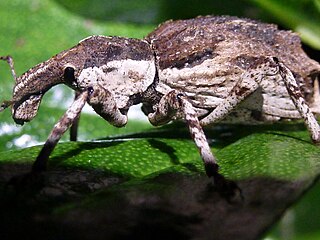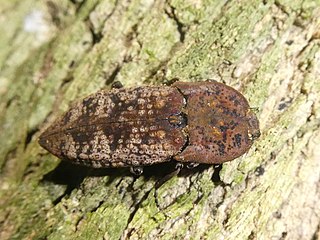
The Polynesian rat, Pacific rat or little rat, known to the Māori as kiore, is the third most widespread species of rat in the world behind the brown rat and black rat. Contrary to its vernacular name, the Polynesian rat originated in Southeast Asia, and like its relatives has become widespread, migrating to most of Polynesia, including New Zealand, Easter Island, and Hawaii. It shares high adaptability with other rat species extending to many environments, from grasslands to forests. It is also closely associated with humans, who provide easy access to food. It has become a major pest in most areas of its distribution.

The Hen and Chicken Islands, usually known as the Hen and Chickens, lie to the east of the North Auckland Peninsula off the coast of northern New Zealand. They lie 12 kilometres (7.5 mi) east of Bream Head and 40 kilometres (25 mi) south-east of Whangārei with a total area of 8.44 km2 (3.26 sq mi).

The New Zealand bellbird, also known by its Māori language names korimako, makomako and kōmako, is a medium-sized species of honeyeater endemic to New Zealand. It has been the only living member of the genus Anthornis since the Chatham bellbird went extinct in the early 20th century. The bellbird's closest living relative is the only other New Zealand honeyeater, the tūī. The bellbird forms a significant component of the famed New Zealand dawn chorus of birdsong, which was much noted by early European settlers. Exceptional singing abilities were already observed by Captain James Cook, who described its song as "like small bells most exquisitely tuned".

Anagotus stephenensis, commonly known as the ngaio weevil, is a large flightless weevil that is only found on Stephens Island in New Zealand. The ngaio weevil was discovered in 1916 by A.C. O'Connor on Stephens Island. Thomas Broun described it in 1921 as Phaeophanus oconnori after its collector. The weevils were observed at the time to be 'feeding on tall fescue and the leaves of trees'.

Anagotus fairburni or Flax weevil is a large flightless weevil. It feeds on leaves of New Zealand flax species where it produces a characteristic feeding notch. It is found on islands and in alpine areas of New Zealand.

The North Island saddleback is a forest-dwelling passerine bird species endemic to the North Island of New Zealand. It was once considered conspecific with the South Island saddleback. The IUCN lists the species as Near Threatened, while it is listed as a "recovering" species in the New Zealand Threat Classification System. Saddlebacks are known in Māori as tīeke.

Evan Graham Turbott was a New Zealand ornithologist, zoologist, and museum administrator. He served as director of the Auckland Institute and Museum from 1964 to 1979.

Amychus granulatus, commonly known as the Cook Strait click beetle, is a large flightless click beetle in the family Elateridae.

Proterodesma turbotti is a species of moth in the family Tineidae. It was described by John Salmon & John David Bradley in 1956. This species is endemic to New Zealand, found in the Antipodes Islands and Bounty Islands of the New Zealand Subantarctic Islands.
Subantarctia turbotti is a species of spider in the family Orsolobidae. The species is endemic to New Zealand.

Allodiscus turbotti is a species of land snail in the family Charopidae. The species was first described by Baden Powell in 1948, and is endemic to Manawatāwhi / Three Kings Islands in New Zealand.
Apatochernes turbotti is a species of pseudoscorpion in the family Chernetidae. The species was first described by Max Beier in 1969, and is endemic to New Zealand.

Cambridgea turbotti is a species of spider in the family Desidae. The species was first described by Ray Forster and Cecil Louis Wilton in 1973, and is endemic to New Zealand.
Dicyrtomina turbotti is a species of springtail belonging to the family Dicyrtomidae. The species was first described by John Salmon in 1948, and is endemic to Manawatāwhi / Three Kings Islands in New Zealand.
Exeiratus turbotti is a species of weevil belonging to the family Curculionidae. The species was first described by Albert Eugene Brookes in 1951, and is endemic to the Auckland Islands in New Zealand.

Mimopeus turbotti is a species of darkling beetle belonging to the family Tenebrionidae. The species was first described by John Charles Watt in 1988, and is endemic to Manawatāwhi / Three Kings Islands in New Zealand.
Paralaoma turbotti is a species of land snail in the family Punctidae. The species was first described by Baden Powell in 1948, and is endemic to Manawatāwhi / Three Kings Islands in New Zealand.
Pholcomma turbotti is a species of spider in the family Theridiidae. The species was first described by Brian John Marples in 1956. Formerly thought to be endemic to Manawatāwhi / Three Kings Islands to the northwest of New Zealand, the species has since been identified on Cuvier Island.

Pseudopisalia is a monotypic genus of rove beetle belonging to the family Staphylinidae. The sole species found in this genus is Pseudopisalia turbotti. Both the genus and species were first described by Malcolm Cameron in 1950. Pseudopisalia turbotti is endemic to Manawatāwhi / Three Kings Islands in New Zealand.

Xenosciomyza turbotti is a species of fly in the family Helosciomyzidae. The species was first described by Roy A. Harrison in 1955, and is endemic to the Auckland Islands south of New Zealand.














